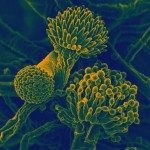Link to Pubmed [PMID] – 21366519
Curr Drug Targets 2011 Jun;12(7):978-99
To gain an in-depth grasp of infectious processes one has to know the specific interactions between the virulence factors of the pathogen and the host defense mechanisms. A thorough understanding is crucial for identifying potential new drug targets and designing drugs against which the pathogens might not develop resistance easily. Model organisms are a useful tool for this endeavor, thanks to the power of their genetics. Drosophila melanogaster is widely used to study host-pathogen interactions. Its basal immune response is well understood and is briefly reviewed here. Considerations relevant to choosing an adequate infection model are discussed. This review then focuses mainly on infections with two categories of pathogens, the well-studied Gram-negative bacterium Pseudomonas aeruginosa and infections by fungi of medical interest. These examples provide an overview over the current knowledge on Drosophila-pathogen interactions and illustrate the approaches that can be used to study those interactions. We also discuss the usefulness and limits of Drosophila infection models for studying specific host-pathogen interactions and high-throughput drug screening.

